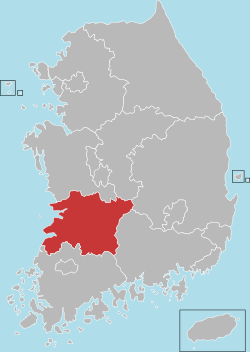Jeonju
| Jeonju 전주시 | ||
|---|---|---|
| Specific city | ||
| Korean transcription(s) | ||
| • Hangul | 전주시 | |
| • Hanja | 全州市 | |
| • Revised Romanization | Jeonju-si | |
| • McCune-Reischauer | Chŏnju-si | |
| ||
 Location in South Korea | ||
| Coordinates: 35°49′N 127°09′E / 35.817°N 127.150°ECoordinates: 35°49′N 127°09′E / 35.817°N 127.150°E | ||
| Country |
| |
| Region | Honam | |
| Administrative divisions | 2 Gu, 40 dong | |
| Government | ||
| • Type | City Government | |
| • Mayor | Kim Seung-soo (Democratic) | |
| • Council | Jeonju City Council | |
| Area | ||
| • Total | 206.22 km2 (79.62 sq mi) | |
| Population (2017) | ||
| • Total | 652,392 | |
| • Density | 3,163.6/km2 (8,194/sq mi) | |
| • Dialect | Jeolla | |
| Time zone | UTC+9 | |
| ZIP codes | 560011-561870 | |
| Area Code | +82 63 | |
| Website | Official website | |
Jeonju (Korean pronunciation: [tɕʌn.dʑu]) is the 16th largest city in South Korea and the capital of North Jeolla Province. It is both urban and rural due to the closeness of Wanju County which almost entirely surrounds Jeonju. (Wanju County has many residents who work in Jeonju.) The name Jeonju literally means "Perfect Region" (from the hanja 全 (전; jeon) for perfect, 州 (주; ju) for region). It is an important tourist center famous for Korean food, historic buildings, sports activities, and innovative festivals.
In May 2012, Jeonju was chosen as a Creative Cities for Gastronomy as part of UNESCO's Creative Cities Network. This honour recognizes the city's traditional home cooking handed down over thousands of years, its active public and private food research, a system of nurturing talented chefs, and its hosting of distinctive food festivals.[1]
History
In the fertile Honam plain, famous for Jeonju Hanok Village and exceptional produce, Jeonju has been an important regional center in the province for centuries. The city was the capital of Hubaekje Kingdom, which was founded by Gyeon Hwon. It was regarded as the spiritual capital of the Joseon Dynasty because the Yi royal family originated there. The Chŏnju Kim in North Korea, who Kim Il-sung was descended from, have their ancestral seat (Bon-gwan) in Jeonju as well.
The town was occupied by the Donghak peasants' movement in 1894. Jeonju was given metropolitan status in 1935, and the city was founded in 1949.
Since Joseon, it was a metropolis but, left behind the industrialization, it declined compared. It does not have the infrastructure, manufacturing, or heavy industries found in other Korean major cities. Today, Traditional Tour is a major industry in the city.
Culture
- Jeonju bibimbap 전주비빔밥, a traditional local food, is well known across South Korea. There are several very popular vegetarian restaurants serving Jeonju style food and pine wine.
- The National Jeonju Museum exhibits ancient relics from the Baekje days.
- There are extensive royal museums, temples, a castle fortress on a hillside, and a well-known paper museum, as well as an annual paper fashion show highlighting the latest styles and traditional Korean clothing made of paper.
- The Jeonju Hanok Village (Hanok Maeul) is a traditional-style village in the heart of Jeonju, housing over 800 traditional "hanok" style buildings. It contains many traditional tea shops, souvenir shops, and restaurants.[2]
- The Jeonju International Sori Festival was among Songlines' 25 Best International Festivals in 2014.
- The Jeonju International Film Festival draws about 50,000 visitors annually.
- Jeonju is the hometown of the breakdancing crew Last for One, international Battle of the Year champions.
The local mountains and parks are popular for outdoor recreation due to its rural location. There are historical sites in the area. The city has a zoo, a park, and the Hanguk Sound and Culture Hall, a large, modern concert complex on the Chonbuk National University campus.
Notable people
- King Yi Seok (born 1941), is the King of Korea.[3]
- Choi Myung-hee (1947–1998), author of the novel series Honbul that sold over 800,000 copies. She worked on the series for 7 years and 2 months until dying due to cancer.
- Kim Tae-yeon (born 1989), member of the group Girls' Generation
- Kim Sung-kyu (born 1989), member of boy band Infinite
- Kim Kyu-jong (born 1987), member of boy band SS501
- Lee Min-woo, member of Shinhwa
- Ahn Hye-jin (Hwasa, born 1995), member of girl group Mamamoo
- Jung Whee-in (born 1995), member of girl group Mamamoo
- Jang So-jin (Soyee, born 1996), member of girl group Gugudan
- Yoon Kyun-sang (born 1987), actor
- Kim Hyun-jin (born 2000), member of girl group Loona
- Choi Byungchan (born 1997), member of boy group Victon
- Choi Chanhee (born 1998), member of boy group The Boyz
- Hansol Vernon Chwe (born 1998), member of boy group Seventeen
Administrative districts
Jeonju is divided into two wards, Deokjin-gu (덕진구) and Wansan-gu (완산구) that, in turn, are divided into approximately 40 neighborhoods.
Transportation
Many city buses and taxis are available in Jeonju. However, tourists are often advised to walk between points of interest, as many attractions are near each other.[4]
Attractions
- Jeonju International Film Festival usually runs from the end of April to May for one week annually.[5]
Sports
Jeonju hosts K League team Jeonbuk Hyundai Motors FC. The team's home ground is the Jeonju World Cup Stadium.[6]
Climate
| Climate data for Jeonju (1981–2010, extremes 1918–present) | |||||||||||||
|---|---|---|---|---|---|---|---|---|---|---|---|---|---|
| Month | Jan | Feb | Mar | Apr | May | Jun | Jul | Aug | Sep | Oct | Nov | Dec | Year |
| Record high °C (°F) | 18.3 (64.9) |
21.9 (71.4) |
28.2 (82.8) |
31.2 (88.2) |
35.1 (95.2) |
35.8 (96.4) |
38.6 (101.5) |
38.3 (100.9) |
34.5 (94.1) |
30.8 (87.4) |
28.0 (82.4) |
23.0 (73.4) |
38.6 (101.5) |
| Average high °C (°F) | 4.4 (39.9) |
6.9 (44.4) |
12.4 (54.3) |
19.6 (67.3) |
24.5 (76.1) |
27.9 (82.2) |
30.2 (86.4) |
31.0 (87.8) |
27.0 (80.6) |
21.5 (70.7) |
13.9 (57) |
7.1 (44.8) |
18.9 (66) |
| Daily mean °C (°F) | −0.5 (31.1) |
1.5 (34.7) |
6.3 (43.3) |
12.8 (55) |
18.2 (64.8) |
22.5 (72.5) |
25.8 (78.4) |
26.2 (79.2) |
21.5 (70.7) |
15.0 (59) |
8.3 (46.9) |
2.2 (36) |
13.3 (55.9) |
| Average low °C (°F) | −4.6 (23.7) |
−3.0 (26.6) |
1.2 (34.2) |
6.7 (44.1) |
12.5 (54.5) |
17.8 (64) |
22.4 (72.3) |
22.6 (72.7) |
17.1 (62.8) |
9.8 (49.6) |
3.5 (38.3) |
−2.2 (28) |
8.6 (47.5) |
| Record low °C (°F) | −17.1 (1.2) |
−16.6 (2.1) |
−12.2 (10) |
−3.9 (25) |
2.2 (36) |
8.2 (46.8) |
12.1 (53.8) |
12.5 (54.5) |
4.0 (39.2) |
−2.7 (27.1) |
−8.4 (16.9) |
−15.0 (5) |
−17.1 (1.2) |
| Average precipitation mm (inches) | 32.7 (1.287) |
40.0 (1.575) |
54.3 (2.138) |
77.3 (3.043) |
91.5 (3.602) |
167.9 (6.61) |
299.6 (11.795) |
277.5 (10.925) |
137.6 (5.417) |
53.5 (2.106) |
50.2 (1.976) |
31.1 (1.224) |
1,313.1 (51.697) |
| Average precipitation days (≥ 0.1 mm) | 9.3 | 7.8 | 10.3 | 8.6 | 9.2 | 10.7 | 15.9 | 15.5 | 9.7 | 6.7 | 9.1 | 9.4 | 122.2 |
| Average snowy days | 8.7 | 5.6 | 2.7 | 0.1 | 0.0 | 0.0 | 0.0 | 0.0 | 0.0 | 0.0 | 1.5 | 6.7 | 25.4 |
| Average relative humidity (%) | 68.6 | 66.5 | 63.7 | 60.6 | 65.3 | 71.3 | 77.5 | 76.7 | 74.1 | 70.4 | 69.1 | 68.9 | 69.4 |
| Mean monthly sunshine hours | 151.6 | 157.7 | 185.9 | 211.7 | 217.9 | 172.7 | 136.7 | 160.6 | 168.1 | 194.6 | 154.5 | 142.3 | 2,054.5 |
| Percent possible sunshine | 48.7 | 51.3 | 50.1 | 53.9 | 50.0 | 39.6 | 30.8 | 38.4 | 45.1 | 55.6 | 50.0 | 47.0 | 46.2 |
| Source: Korea Meteorological Administration[7][8][9] (percent sunshine and snowy days)[10] | |||||||||||||
Jeonju has a cooler version of a humid subtropical climate (Köppen climate classification Cfa/Cwa). Jeonju, like all of Korea, has four distinct seasons (spring, summer, fall, and winter). The winters can have a mix of days that are cool to days that are quite cold. The colder days are often influenced by a high pressure front that brings cold air from Siberia.
In the summer, the humidity over the Korean peninsula from June through September comes from southeast Asia. Temperatures in spring (late April and through May) and fall (after September 25 and though October) are often in the mid-20s℃ and with low humidity.
Sister cities
Gallery
- Central neighbourhood (Wansan District) of Jeonju during the period of Japanese rule
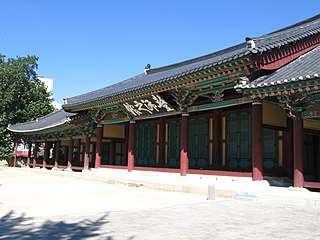 Jeonju Gaeksa
Jeonju Gaeksa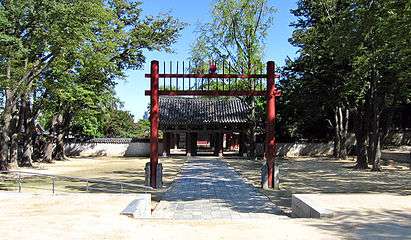 Jeonju Gyeonggi-jeon
Jeonju Gyeonggi-jeon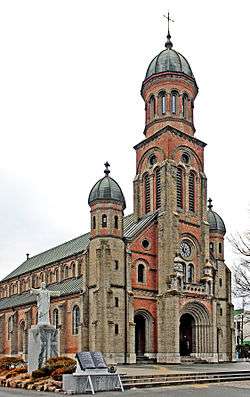 Jeondong Catholic Church.
Jeondong Catholic Church.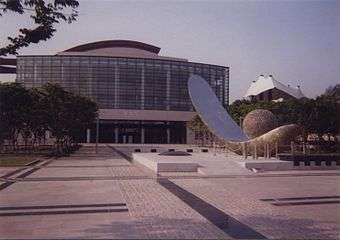 Sori Art Center of Jeollabuk-do.
Sori Art Center of Jeollabuk-do.- Night view of Jeondong Catholic Church.
- Jeonju outskirts at sunset (August 2012).
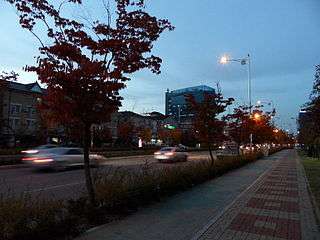 Bicycle lane with sidewalk - Jeonju, South Korea.
Bicycle lane with sidewalk - Jeonju, South Korea.- Trails along the Samcheon (river), 2014.
- Along Jeonju River and across from Nambu Market.
- Jeonju Hanok Village, 2014 (1).
- Jeonju Hanok Village, 2014 (2).
- Jeonju Hanok Village, 2014 (3).
- Gyeongi jeon entrance (2014).
- Jeondong Catholic Church (Jeonju), 2014.
- Jeonju Chinatown, 2014.
- Gaeksa shopping area, 2014.
- Outdoor city park (Jeonju, Hyoja Dong), 2014.
- Jeonju trail network, 2014.
.jpg) Jeonju, South Korea (view over Hyoja Dong), June, 2016.
Jeonju, South Korea (view over Hyoja Dong), June, 2016..jpg) Jeonju, South Korea (view over Hyoja Dong), June, 2016.
Jeonju, South Korea (view over Hyoja Dong), June, 2016.
See also
References
- ↑ "Jeonju's Gastronomic Greatness Recognized by UNESCO". Chosun Ilbo. 16 May 2012. Retrieved 23 May 2012.
- ↑ Jeonju Hanok Village. Visitkorea.or.kr. Retrieved on 2013-07-12.
- ↑ "순종".
- ↑ "Travel Highlights". visitkorea. Retrieved 7 December 2014.
- ↑ "Jeonju Int'l Film Fest to Open This Week". Chosun Ilbo. 23 April 2012. Retrieved 23 April 2012.
- ↑ Jeonbuk Hyundai Motors, Jeonbuk Hyundai Motors (2016-04-14). "Jeonbuk Hyundai Motors".
- ↑ "평년값자료(1981–2010) 전주(146)" (in Korean). Korea Meteorological Administration. Retrieved 23 December 2016.
- ↑ "기후자료 극값(최대값) 전체년도 일최고기온 (℃) 최고순위, 전주(146)" (in Korean). Korea Meteorological Administration. Retrieved 23 December 2016.
- ↑ "기후자료 극값(최대값) 전체년도 일최저기온 (℃) 최고순위, 전주(146)" (in Korean). Korea Meteorological Administration. Retrieved 23 December 2016.
- ↑ "Climatological Normals of Korea" (PDF). Korea Meteorological Administration. 2011. p. 499 and 649. Archived from the original (PDF) on 7 December 2016. Retrieved 23 December 2016.
External links
| Wikimedia Commons has media related to Jeonju. |
| Wikivoyage has a travel guide for Jeonju. |

